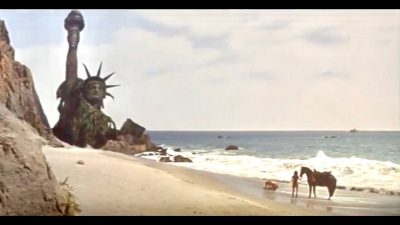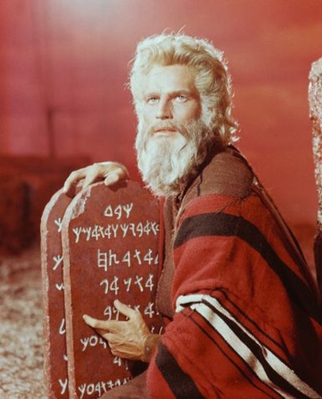
There is more to Moses than Charlton Heston. Ignore the theology. Ignore the special effects. Ignore Cecil B. DeMille. Instead focus on the political. Focus on the fact that when Israel emerged in history it did not have a king, it did not have a temple, it did not have a capital city. It was not a nomadic people. Yet somehow people still were able to identify themselves as Israel. What the people did have that no one else had was a covenant. While not exactly a Constitution, it did serve to define the people. Whereas our defining document begins with WE THE PEOPLE, Israel’s began with “Yahweh thy God took thee out of the land of Egypt (Ex. 20:2).
Pharaoh Merneptah (1212-1202 BCE), the son and successor to Ramses II, claimed to have destroyed the seed of Israel. When the Merneptah Stele was discovered in 1896 with these words, it caused quite a stir as you might imagine.

Merneptah used an indentifier with the word “Israel” to indicate that Israel was a not a settled people as were the people of the Canaanites cities that Egypt had ruled for centuries. But they were not nomads in the land of Canaan either. So what were they?
Archaeologists have discovered hundreds of small unwalled settlements in the land of Canaan that date to this time. They are considered to be Israelite because realistically speaking who else could they be? Merneptah knew there was a people Israel there and they knew they were not a city-based people. So how did they maintain their identity?
The answer is the covenant renewal ceremony. They were united by an idea. Israel was not a people based on geography. It was not a people based on race. It was not a people based on ethnicity. It was a people based on an idea expressed in the covenant and later physically expressed in the Ark of the Covenant. Periodically, the people met (or at least the elders did) to renew that sense of identity. At first Israel did so at Mount Ebal as instructed by Moses (Deut. 11:29, 27:4, 13) and done by Joshua (Josh, 8:30-35). Archaeologists have discovered the altar used in the ceremonies but the consequences of admitting it are too much to accept.
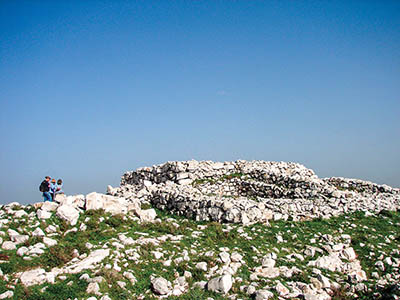
After Mount Ebal, the covenant renewal ceremony relocated to Shiloh. Shiloh also served as a place for men to bring the unmarried women in their family to find mates (Judg. 21:19-23) much like the camp meetings in the early 1800s in the United States. The ark remained at Shiloh until it was captured by the Philistines.
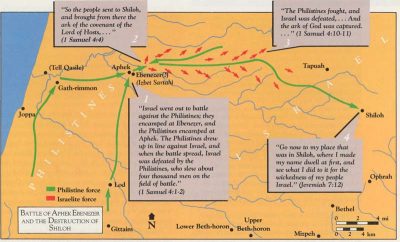
When David became king of all Israel, he continued this tradition of defining the people based on an idea. He brought the ark to Jerusalem, his new capital. Jerusalem, unlike with the founding of Washington, DC, had been enemy territory for centuries. Based on the archaeological record, Jerusalem had been a good vassal of Egypt during the more than three centuries of Egyptian rule in the land of Canaan.
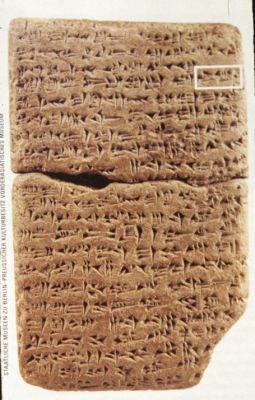
It is reasonable to conclude that Jerusalem like other vassal cities would have joined with Pharaoh Merneptah against the newcomer Israel. And according to the biblical account, Jerusalem organized a coalition against Israel (Josh. 10:1-5). In the biblical accounts of this time period, Jerusalem definitely is not part of Israel (Judg. 1:7-8, 21; 19:11-12).
Yet David makes the enemy city his capital. He installs the ark there (II Samuel 6). He buys land there from most likely the Jebusite king of the city and the Temple of Solomon would be built there (II Sam. 24:16-25; I Chr. 24:15-30; II Chr. 3:1). He does not massacre the Jebusite inhabitants of the city. Instead he welcomes them into his kingdom, his government, his family. Consider the words of Rahab the Canaanite, the female figure used to symbolize the Canaanite people who are now under the rule of David, King of Israel.
Joshua 2:10 For we have heard how Yahweh dried up the water of the Red Sea before you when you came out of Egypt, and what you did to the two kings of the Amorites that were beyond the Jordan, to Sihon and Og, whom you utterly destroyed.
Note that the Canaanites have heard what Yahweh has done. By contrast, the Israelites had seen what Yahweh had done.
Exodus 14:13 And Moses said to the people, “Fear not, stand firm, and see the salvation of Yahwweh, which he will work for you today; for the Egyptians whom you see today, you shall never see again.
In this contrast between those who saw and those who heard, one may recognize the difference between the Sons and Daughters of the American Revolution and the naturalized Americans who have no biological link to the Patriot cause. It is precisely this distinction and inclusion that Lincoln will replicate at Gettysburg (see below).
Before Lincoln did do that, four score and seven years earlier, the Founding Fathers had to first create the United States of America based on an idea. To understand what they accomplished it is necessary to put aside our racial classification system. Based on the standards of the time, they were trying to create “WE THE PEOPLE” out of a disparate amalgamation of peoples. There were English of various types, Scotch Irish, Irish Catholic, Dutch, Palatine Germans, Sephardic Jews, and French Huguenots among other peoples. There was no precedent for combining such a diversity into a non-imperial republic. Certainly no political entity was organized on such a basis in Euope. The idea of constituting themselves as a people was farfetched to say the least. They knew it was an experiment. They knew it might not work. They probably would be shocked by the idea of a pending 250th anniversary for such a political entity.
Lincoln at Gettysburg continued this definition of the political entity based on an idea. When he said “Four score and seven years ago, our fathers,” he knew that not everyone in his audience was a son or daughter of the American Revolution. But just as David included in the political kingdom of Israel people who had not been part of the people of Israel that Merneptah had claimed to have destroyed two centuries earlier, so Lincoln linked all the Americans of his present to the events 76 years earlier. If you stood for the Union now, you were one with those who had created the Union then.
This idea took a giant leap forward for humanity with Captain Kirk on the Starship Enterprise. His hero was Lincoln so I presume Lincoln was a hero to Gene Roddenberry as well. Earth like the 13 states was part of a Federation. Beings of different races were joined together in a single entity. The precise details of how the Federation of Planets operated are not the issue here. What is the issue is the concept of beings becoming one without abandoning their individuality as with the Borg or in Mainland China. In this regard, Federation with its Prime Directive and other defining principles is another step on a journey that began millennia earlier when a mixed multitude entered into a covenant. They are united not by geography, not by race, not by ethnicity, but by an idea.
It’s all one story. Moses in the wilderness with the covenant, David at Zion with the Ark of the Covenant, the Founding Fathers with the Constitution, Lincoln with the Gettysburg Address, Kirk on the Enterprise are all part of a single story. As the Ark of the Covenant once was the physical expression of the covenant idea that defined Israel, so the Statue of Liberty is the physical expression of the idea that defines the United States. Both for the people who come here and those in Hong Kong, Russia, and elsewhere, the Statue of Liberty is the global symbol for people who want to be free. So which Charlton Heston ending will America choose? The Charlton Heston of The Ten Commandments who ends the movie with the words of the Liberty Bell to proclaim liberty throughout the land (Lev. 25:10) or the Charlton Heston of Planet of Apes overwhelmed by the sight of the Statue of Liberty buried in the sands?
